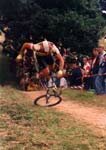|
Remember, that wearing a helmet does not make you indestructible and that it is definitely better to prevent accidents or incidents through safer cycling than relying on a helmet to offer protection if you get it wrong. Plus you should only wear a helmet designed for cycling and choose one that has plenty of vents as  you could be sweating up a storm. you could be sweating up a storm.
Helmets sold in e-cobr bike shops will be tested to certain standards. The best test is the Snell Foundation test. Other tests of note include ANSI (US) and BS (British).
Helmet fitting instructions.
Your helmet should not flop around on your head. Use the pads provided to gain a snug fit. A correctly fitting helmet should take the scalp with it when it is moved back and forth.
Don't tip your helmet to the back of your head. It is intended to protect the forehead and anyway it catches the wind this way and slows you down. Allow only a two finger gap between your eyebrows and the peak of your helmet.
Damage or aging
Any helmet suffering a severe blow should be replaced immediately, even if you cannot see any damage. Many manufacturers will, within a specific time period, supply a replacement helmet at a reduced price. It is also recommended that helmets older than perhaps 2-3 years should be changed.
When kids fall off............it is quite often their head which hits the ground first, they seem to be 'top heavy'. You'll therefore be pleased to know that cycle helmets are really at their most effective at slow speeds.
Always make sure your child likes their helmet, it really shouldn't matter what you think about it. Providing it meets the necessary safety standards, let them choose it. Remember, you want them to wear it rather than remove it once you're out of sight.
At the risk of being accused of scare mongering; here's what can happen if you don't wear a helmet.
|